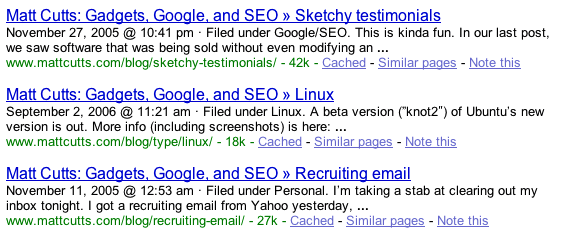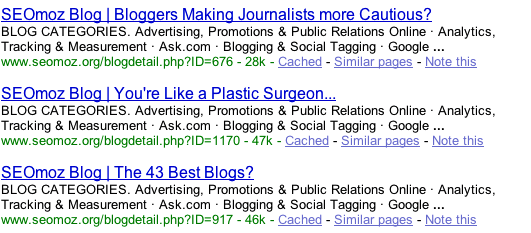It’s been said that meta keywords and description tags are dead. Where as I’d agree with the keywords tag, the descriptions tag I’m no longer convinced is dead. Actually, it’s quite important; especially for blogs.
If you use the site: command in Google, and look at Google’s descriptions (aka snippits) for a blog, you may notice some indexing issues. Usually one of two things happens. Either your blog description is generic and includes things like the date and categories, or your blog’s description is exactly the same. The second one will probably land a lot of your pages in the supplemental index.
If you check out Matt Cutt’s blog, you’ll notice that the descriptions start with the date followed by time, categories and then the first few words of his post.

Check out SEOMoz’s blog and you’ll see that most blog posts are showing up as supplementary results as all the descriptions are exactly the same “BLOG CATEGORIES. Advertising, Promotions & Public Relations Online · Analytics, Tracking & Measurement · Ask.com · Blogging & Social Tagging · Google …”

The reason for this is that Google is reading the sites from the top down and taking the first x number of indexable characters. It’s not actually giving a description based on what is written in the blog post. This is not only causing fewer pages to be indexed, but it’s also causing less pages to be ranked well.
What can you do? Put in unique meta data tags for each page. It’s as simple as that.
After I installed the Headspace plugin on a few blogs, the issue went away in just a couple of weeks. All the pages were re-indexed, with better descriptions, and all the results that were supplemental results were no longer supplemental.
Headspace is my plugin of choice, but there are other options. Including: Tags in the Head, Meta SE, Head Meta Description and more.
One can also setup custom fields if they don’t want to use a plugin. See WordPress’ documentation on this one.
Setting up your blog, without meta descriptions, may cause odd indexing issues and less exposure. Adding unique meta descriptions are very easy and something that every blog should have in order to get the best possible indexing from a search engine. So what are you waiting for?
[tags]Google, Matt-Cutts, SEOMoz, Headspace, Meta[/tags]


